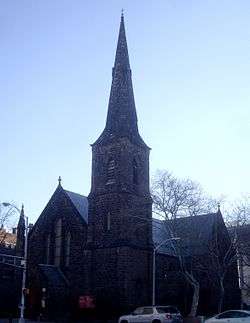Grace Church (Newark)
|
Grace Church | |
 | |
 | |
| Location | 950 Broad Street, Newark, New Jersey |
|---|---|
| Coordinates | 40°43′50.22″N 74°10′27.77″W / 40.7306167°N 74.1743806°WCoordinates: 40°43′50.22″N 74°10′27.77″W / 40.7306167°N 74.1743806°W |
| Built | 1847 |
| Architect | Richard Upjohn, C. Harrison Condit |
| Architectural style | Gothic Revival |
| NRHP Reference # | 72000776 |
| NJRHP # | [1] |
| Significant dates | |
| Added to NRHP | November 2, 1972[2] |
| Designated NHL | December 23, 1987[3] |
Grace Church in Newark (Episcopal), located at 950 Broad Street in Newark, Essex County, New Jersey, United States, was founded on Ascension Day in 1837 at the behest of Bishop George Washington Doane, who intended it to be the standard bearer for Anglo-Catholicism in the northern part of his diocese (which then comprised the whole state of New Jersey).
The church building, designed by Richard Upjohn, who was also the architect of Trinity Church, New York, was consecrated on October 5, 1848. It is widely esteemed as an outstanding example of Gothic Revival architecture in the United States. The church was built on the site of the old Essex County Courthouse and Jail which burnt down on August 15, 1835.[4]
In Grace Church's liturgy the tradition of ceremonial grandeur inherited from the nineteenth-century Catholic Revival mingles with the influence of the twentieth-century Liturgical Movement. Incense, lights, and beautiful vestments are used, but the ceremonial is intelligible, and the contemporary-language rite from the 1979 Book of Common Prayer (Rite II) is used. Active participation of the people is encouraged.
Music plays an important role in worship. At the 10:30 Mass on Sundays most of the liturgy is sung—some parts by the congregation and others by a small choir. The chants of the proper of the Mass are sung to their proper Gregorian Chant melodies. From September through June the choir sings other liturgical music of all periods, with emphasis on Renaissance polyphony. The choir often offers a mass setting including the Kyrie, Gloria, and Agnus Dei. The congregation sings three hymns, the Credo, Sanctus, psalm refrain, and other responses.
The organ is a 48-stop tracker instrument built by Casavant Frères in 1990.
The Grace Church Music Society, organized in 2008, each year sponsors a series of recitals and concerts.
The diverse congregation includes people from Africa and the Caribbean as well as Europeans, Caucasian Americans, and African Americans. Its members are young and old, married and single, gay and straight.
The parish is committed to Catholic faith and practice in The Episcopal Church, but receptive to new insights, including the ordination of women and affirmation of homosexual relationship.
The Rev. Dr. J. Brent Bates became the parish's seventeenth rector in March 2011. James M. Hopkins is the director of music. He recently succeeded Joe Arndt who held the position from 2009-2015, and James McGregor, who held the position for the previous forty-eight years.
See also
References
- ↑ "New Jersey and National Registers of Historic Places - Essex County" (PDF). New Jersey Department of Environmental Protection - Historic Preservation Office. April 1, 2010. p. 5. Retrieved August 21, 2010.
- ↑ Staff (2010-07-09). "National Register Information System". National Register of Historic Places. National Park Service.
- ↑ NPS Summary
- ↑ "THE OLD JAIL ON NEW STREET". New Jersey History's Mysteries. Retrieved 21 August 2010.
External links
| ||||||||||||||||||||||||||